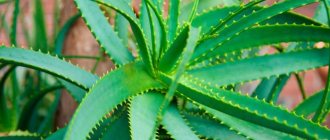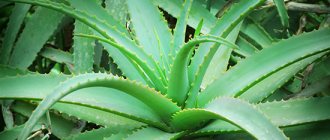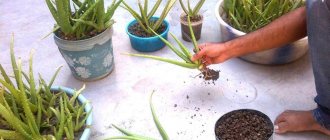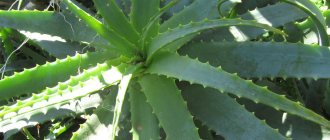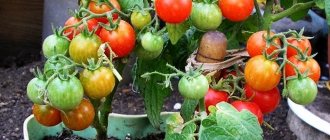Botanical description
Attention : In the scientific literature, this variety of aloe is usually called variegata; in order to grow it, you need to know how to properly care for it. Among gardeners, the indoor plant is called Falcon feather or tiger aloe.
This variety belongs to the perennial leaf succulents of the Asphodelaceae family . The homeland is considered to be South Africa and Namibia. In nature it prefers rocky areas. It grows as a compact bush up to 30–35 cm high. The stem is small. The bush is dense, compact.
The peculiarity of the variety is that the leaves grow in three rows and are arranged in a spiral. The leaves are deep green and pointed. They grow up to 12 – 15 cm in length, 4 – 5 cm in width at the base. The lower leaves die over time and turn brown. They gather into a small rosette and tightly entwine the stem. The structure of the leaves is dense and fleshy.
The peculiarity of the variety is the coloring of the leaves . There are white marks - spots - across the entire surface of the leaf. Spots and stripes are located symmetrically on the leaves. The edges of the leaf are covered with small spines. The leaf is triangular in shape, edged with a narrow white stripe. The root is powerful and well branched.
On our website you can find out a lot of useful information about varieties such as Aloe vera, tree, striped and spinous. We also suggest reading the article “Beautiful and unusual aloe mix - medicinal properties of varieties, features of care and propagation,” where you will find a description of many varieties and types of aloe.
Description
Gonialoe variegata is a small succulent without stems, up to 30 cm high and up to 25 cm wide, with 16-26 smooth dark green, unevenly variegated leaves, growing in three rows from the center to the edge, 6-8 in each row. The variegation of the leaves is given by lighter transverse group lined inclusions, reminiscent of tiger stripes - the darker areas are successively replaced by light green ones. The leaves can reach a length of 20 cm and a width of up to 6 cm, the edges are sporadically armed with white teeth. If there is a lack of moisture, the foliage may become reddish in color, and if there is a long absence of water, it may become light brown.
Flowering begins in late spring, in the fifth year of life. The peduncles are large, up to 45 cm in length, mostly branched, ending in cone-like inflorescences. The flowers are elongated, about 2.5 cm, tubular with six petals, the average number in an inflorescence is about 30. The flowering period lasts from July to September. The flowers are usually orange with a greenish edge, but colors can range from flesh pink to dull red and rarely yellow.
The root system is developed, fibrous, with adventitious processes oval in diameter. The average lifespan of a plant is 15-20 years.
This attractive succulent was first discovered on October 16, 1685 on the Namaqualand plateau during Simon Van Der Stell's expedition to South Africa. Most often in the wild, Tiger Aloe can be found in arid or semi-arid regions of the Republic of South Africa and southern Namibia. Since its discovery, it has enjoyed constant popularity among residents of Europe, where it is cultivated as a houseplant and garden plant (in the southern regions).
Medicinal and beneficial properties
The diverse and rich chemical composition of variegated aloe:
- Amino acids – glycine, licine.
- Polysaccharides.
- Flavonoids.
- Minerals - iron, chlorine, zinc.
- Vitamins – ascorbic acid, carotene, vitamin B.
In pharmacology, the juice of the plant is used to produce bactericidal preparations for abscesses and other skin inflammations. In medicine it is used as a diuretic. Preparations based on natural raw materials are used for eye inflammation and runny nose. Aloe juice is used internally for digestive disorders .
In folk medicine, a leaf cut in half is applied to wounds and abrasions. The juice has healing properties. For cosmetic purposes against acne, masks and tonics based on plant juice are used.
Home care
Temperature
Variegated aloe does well at room temperature . In summer, the optimal temperature is up to 22 °C. You can take the pots out onto an open loggia or veranda. The flower loves fresh air, but does not tolerate drafts.
In autumn and winter, at rest, the air temperature should be reduced to 10 - 12 °C.
Watering
The flower should be watered moderately, regularly, once a week in the spring and summer . In winter, watering is reduced; light moistening of the substrate is sufficient once every 3–4 weeks.
This variety requires low air humidity up to 40%. The flower does not need spraying. In the summer heat, it is advisable to wipe the leaves with a damp cloth to remove dust once a week.
When watering, water should not fall on the leaves and into the outlet; it should be poured under the root. Watering should be done with warm, settled water.
Light
Aloe Variegata loves well-lit places . You can install pots on south-facing windows. At lunchtime, it is better to shade the windows with a light curtain.
In winter, additional lighting for 3 hours a day is desirable.
Trimming
This flower does not need form-building trimmings from the bush.
After flowering, it is necessary to cut off dried flower stalks . Old, yellowed, lower leaves are also cut off.
Feeding
Fertilizers are applied during the active phase of flower growth, in spring and summer, once a week. In autumn, fertilizing is reduced; it is enough to apply fertilizer once a month.
Special complex mineral fertilizers for succulents are used as fertilizers . Flower growers recommend using ash, humus, and vegetable decoctions as organic fertilizers. Liquid fertilizers are applied through irrigation. Immediately after transplantation, fertilizers are not applied for 2–3 weeks.
Pot
For planting adult flowers, it is recommended to use ceramic or clay pots. As the root grows with age, the plastic pot may tip over. Young seedlings can be planted in plastic flowerpots until they are 2–3 years old.
Planting containers must have drainage holes for good air permeability. The pot should not be very deep, but spacious and wide.
Transfer
For replanting, you should first prepare special soil . The soil should be light, loose, well drained. It is better to purchase a special mixture for succulents in the store. You can prepare the soil mixture at home.
Soil composition for variegated aloe:
Rotted compost – 1 tsp.
- Coarse sand – 1 tsp.
- Drainage.
You can also use a mixture of turf soil, leaf soil, sand, in a ratio of 2:1:1.
Flowers are usually replanted in the spring . Young bushes require annual replanting, adult plants are replanted once every 2 to 3 years.
Transplantation scheme:
- A drainage layer 2 cm high is poured onto the bottom.
- The soil is poured.
- The substrate is moistened.
- Transplantation is carried out using the transshipment method; the flower is transferred to a pot along with a lump of earth.
- Air temperature - up to 20 °C.
- Moisten the soil regularly, in small doses.
We recommend watching a video about transplanting variegated (tiger) aloe:
Caring for aloe variegated at home
Aloe spinosa or aristata - what kind of flower is it?
In the wild, the crop prefers an arid climate. In order for aloe variegation to develop well at home, you need to follow some care features.
Illumination and temperature conditions
Proper placement is the main requirement for the development of spotted aloe. It is necessary to install the container with the culture in a well-lit place. If there is a lack of light, special lamps are additionally used. However, in the warm season, the plant prefers a little partial shade, which will reduce the risk of burns on the leaves. In indoor conditions, the flower should be placed on window sills located on the south side of the house. The suitable temperature for aloe is 12-18 degrees Celsius.
Features of plant care
Watering rules and humidity
The variety is undemanding to moisture, so watering is rare. In the hot season, the bush should be watered once every 10 days; in winter, the frequency is reduced to once every 2 weeks. Liquid is added only when the soil in the pot becomes dry. Regular soil moisture leads to rot on the roots and can harm the plant.
Fertilizing and soil quality
The plant is fed only with liquid fertilizers. To do this, the product is diluted in water and applied to the soil by watering. Mineral fertilizers designed specifically for succulents are used for the flower. You can also use wood ash, humus or vegetable decoction. Fertilizing is applied once a month.
The soil is chosen so that it allows air to pass through well. When making your own soil, you need to mix one part of garden soil, one part of humus and part of coarse river sand. The top nutrient layer must be lined with coarse sand or small pebbles.
Important! If the soil for planting is prepared independently, it must be disinfected. For this, a light solution of manganese is used.
Flower container size
When choosing a container for planting aloe variegata, it is important to ensure that the roots of the plant do not rest against the walls. The best solution is loose pots. During the growth period, the bush is replanted and the soil is replaced.
Important! For planting, you need to use wide ceramic pots, this makes caring for the plant easier.
Choosing a pot for planting aloe
Pruning and replanting
The plant should be inspected and sanitary pruning carried out. At the same time, all damaged and dried leaves are removed. When the buds wither, it is also recommended to remove the flower stalks.
Reproduction
By shoots
Aloe variegated easily reproduces by apical and lateral shoots . This method is very convenient even for a novice gardener. The shoots quickly take root, practically do not get sick, and quickly adapt.
Shoot rooting scheme:
- Shoots 6–7 cm long are cut off and dried in the shade for 1–2 days.
- The bases of the shoots are treated with charcoal immediately after cutting.
- Drainage and substrate are poured into the pot sequentially.
- Seedlings are treated with any rooting agent.
- They are buried 1–2 cm into the soil.
- Each seedling is tied to a temporary support.
- The soil is not moistened for 5–7 days, then watering is moderate.
- After rooting, the seedlings are placed in separate pots.
Tip : Variegated aloe requires top drainage - a layer of crushed stone is laid on the surface of the soil.
Seeds
This method is less common. The process of growing seedlings from seeds is long, labor-intensive, and requires special conditions .
Seed planting scheme:
The seeds are first soaked in a weak solution of manganese.
- Substrate is poured into a wide planting container.
- The soil is treated with a fungicide and is well moistened.
- The seeds are lightly pressed into the soil.
- The seedlings are covered with film or kept in a greenhouse under glass.
- Seed germination temperature is at least 22 °C.
- The greenhouse is ventilated daily for 15–20 minutes.
- When the first leaves appear on the sprouts, the seedlings are planted in small containers for growth.
- In spring, seedlings are planted in pots.
Aloe Variegated: home care
In order for aloe to grow well and delight you with flowers, it is necessary to follow the watering regime, provide the plant with sufficient lighting and organize the correct temperature regime.
Illumination and temperature conditions
Aloe flower: home care and main varieties
This indoor flower loves bright light, so it must be placed on window sills on the south side of the apartment. In winter, it is worth organizing additional lighting for 3-5 hours a day.
Comfortable air temperature for the plant during the active growing season is 18-24 °C. During the rest period, it is better to lower the temperature to 14-18 °C.
Attention! If the air temperature is too high, the leaves will turn brown. In order to restore their color, the plant must be removed for a week in a shaded place.
Aloe loves bright lighting
Watering rules and humidity
Water the succulent only after the soil has completely dried. In spring and summer, variegated aloe is watered once a week, in autumn and winter - once a month. Air humidity – no higher than 40%. The plant does not need spraying.
Fertilizing and soil quality
To feed aloe, only the root method is used. Fertilizers are applied after watering or diluted directly in water. They use specialized mineral complexes for aloe and succulents. The best organic materials are wood ash, humus and vegetable decoctions.
Important! During the active growing season (from March to September), fertilizing is applied once every seven days. During the dormant period (from October to February), the plant is not fed at all.
The soil for aloe should be light, loose and slightly acidic. To plant a flower, you can use a ready-made substrate or prepare it at home. The composition should be as follows: turf and leaf soil, humus and sand. Everything is taken in equal proportions.
Flower container size
A pot for aloe should be chosen so that it does not differ much in volume from the previous one, otherwise the roots will have to spend a lot of time and effort to gain a foothold in it. It is best to choose a wide pot shape.
Pruning and replanting
In the spring, dried and damaged leaves are pruned, and faded flower stalks are removed. This procedure helps maintain a pleasant aesthetic appearance for the plant.
Young plants aged 1-3 years are replanted annually, since they grow up to 10 cm in one year. After 4 years, the growth rate slows down or stops altogether, so the plant needs to be replanted once every 3-4 years.
Aloe transplant
Diseases
- With excessive watering, the root collar begins to rot. Rot quickly destroys the flower; it is necessary to isolate the diseased plant.
- If the composition of the substrate is incorrect, the flower does not grow, the soil should be replaced, or sand can be added.
- Due to lack of light, the stems become elongated and the leaves lose their attractiveness.
- From an excess of fertilizers, the leaves begin to turn yellow; you should strictly adhere to the timing and proportions of fertilizing.
- Treating the bush with an alcohol or soap solution will help against scale insects and spider mites.





